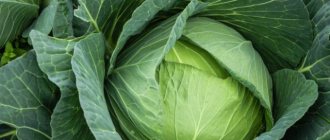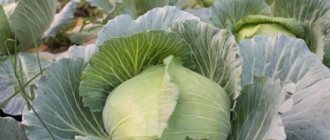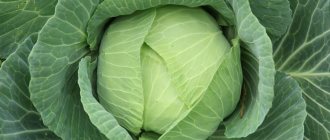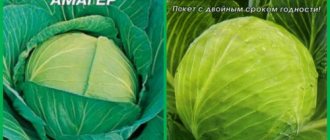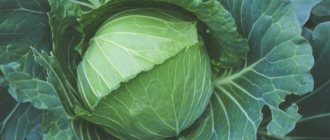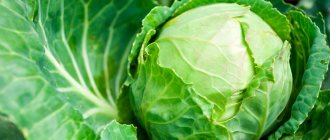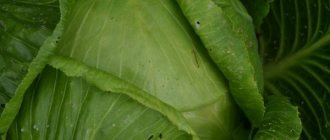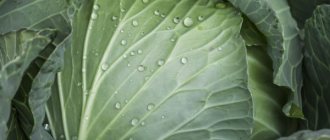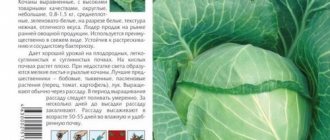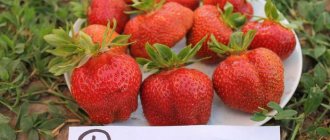Description of cabbage hybrid Tobia f1
The hybrid was bred by Dutch breeders. Experimental samples showed rapid seed germination, early full ripening, and excellent keeping quality. The purpose of creating Tobia f1 was to provide private vegetable growers and farms with cabbage, which can be harvested either manually or mechanized.
Tobia is an early ripening hybrid. The stalk is small, so the plant itself grows short. Thanks to this, the leaves receive accelerated nutrition and nutrients that contribute to the early formation and maturation of the head of cabbage. They are round-flat in shape and differ in density. The inside of the head is white, its average weight is 5-7 kg. The vegetable reaches technical maturity 90 days after germination.
The upper leaves are dark green with light veins, clearly visible, but not too hard. The surface has a waxy coating. The leaf structure is dense, slightly pimply, with wavy edges. During ripening, they curl into a dense head of cabbage.
Disease resistance
Tobia has strong immunity and resistance to many cabbage diseases, including:
- powdery mildew;
- fusarium;
- blackleg;
- late blight;
- white, gray rot;
- mosaic.
Composition and properties
The rich chemical composition makes Tobia f1 hybrid cabbage an ideal way to replenish and saturate the body with useful nutrients. The vegetable contains the following vitamins, macro- and microelements:
- thiamine (B1);
- pantothenic, ascorbic, nicotinic and folic acids;
- riboflavin;
- biotin (H);
- vitamins K and P;
- potassium;
- sodium;
- magnesium;
- phosphorus;
- sulfur;
- cobalt;
- nickel;
- molybdenum;
- silver;
- tin;
- vanadium.
Tobia cabbage is characterized by an abundance of enzymes. The biochemical composition of the crop places it among the irreplaceable food products and endows it with unique medicinal properties. Fresh cabbage juice has been found to be highly effective for healing wounds, stomach and duodenal ulcers. Sauerkraut reduces the risk of developing cancer, normalizes the functioning of the nervous system, strengthens bone tissue, and improves skin and eye health.
Description
Let's get acquainted with the distinctive characteristics of Tobia white cabbage.
Selection
The culture is a hybrid of Dutch origin. The variety was included in the State Register of our country in 2005 and is recommended for cultivation for both personal and industrial purposes. Thanks to the outstanding sustainable qualities of Tobia cabbage, it can be grown in any region of Russia.
Ripening time and yield
The variety is early ripening, reaching technical maturity 90 days after emergence. Tobia can boast of a low stalk, thanks to which the head of cabbage receives increased nutrition and ripens quickly.
The crop is characterized by high productivity: 20 kg of fruits are harvested from 1 m2. If we talk about industrial cultivation, 100 tons of cabbage can be harvested from 1 hectare.
Description of the plant
- The leaves on the outside have a dark green tint and a waxy coating.
- The structure of the leaf is dense, the pimples are weakly expressed, the edges are curled.
- The core of the head of cabbage is light, white-yellow, dense.
- The weight of one head of cabbage reaches 5 kg. If the care and conditions are good, then they can easily reach the seven-kilogram mark.
- The cabbage shape is round and regular.
- The lower leaves are located close to the ground. The veins are noticeably pronounced and stand out against the background of the leaves with a lighter shade.
The main advantages and disadvantages of the cabbage hybrid Tobia f1
Among the main advantages, vegetable growers note:
- Pleasant sweetish taste without bitterness. Cabbage is tasty and healthy in any form - fresh, boiled, fried, salted, stewed, baked.
- Resistance of heads of cabbage to cracking. Even when rotted, during storage and transportation, they retain their integrity.
- Resistant to low temperatures (down to -10°C). Heads of cabbage ripen well in open ground conditions.
- Easy care. Growing does not require the use of special measures or expensive fertilizers.
- Good density and juicy texture.
- High yields. With optimal care from 1 sq. m you can collect more than 20 kg of cabbage. On an industrial scale, up to 100 tons are obtained from 1 hectare.
- Versatility of use in cooking. Thanks to the thin leaves and the absence of thick veins, the vegetable has a delicate texture and pleasant taste. It requires a minimum amount of time to prepare.
Disadvantages of a hybrid:
- low shelf life (3 months);
- close placement of outer leaves to the soil surface (increases the risk of rot development).
Characteristic
Descriptions of cabbage do not always give a complete picture of the variety. To decide to grow, you need to get acquainted with the characteristic features, advantages and disadvantages.
Advantages
- Tobia cabbage is juicy, without bitterness, slightly sweet. The leaves are thin, without rough veins.
- Even overripe heads of cabbage do not crack.
- The variety is high-yielding; up to 20 kg can be harvested per square meter if agricultural practices are followed. If we consider the yield on an industrial scale, then up to 100 tons are harvested from one hectare.
- Excellent transportability.
- White cabbage vegetable is intended for growing in open ground.
- The universal-purpose hybrid is widely used in cooking. Pickled and sauerkraut is especially tasty.
Important! The Tobia hybrid is resistant to many diseases of cruciferous crops, especially Fusarium wilt.
Minuses
Gardeners do not note any particular disadvantages in the Tobia F1 variety, although they exist:
- short fresh shelf life - no more than three months;
- the proximity of leaves to the soil and abundant watering lead to rotting.
Since the variety has a minimal number of negative aspects, Tobia cabbage takes its well-deserved place in the garden beds of Russians.
Features of planting and growing
To obtain a high and high-quality harvest, it is necessary to carry out agrotechnical work correctly. It is best to grow cabbage in seedlings in order to protect the vegetable crop from severe frosts and leave the maximum number of sprouts for ripening.
The timing of planting seedlings varies from April 1 to April 10. This is the most optimal time so that by the end of May the sprouts are completely ready for transplanting into open ground. The development of seedlings from seeds occurs on average 45 days. To grow it, you first need to properly prepare the soil.
Priming
The best substrate is peat filler, since cabbage loves fertile, loose soil. You can use store-bought mixtures, but for vegetable growers it is preferable to prepare the soil yourself. In addition to peat, compost, turf and humus are added.
Several mixture options:
- humus, turf, sand in proportions 50/45/5;
- sand, peat – 50/50;
- compost, turf, peat – 40/30/30;
- peat, turf, sand – 70/25/5.
Before planting the seeds, the soil for planting is well warmed up. The best options are to pour boiling water or heat in the oven at 200°C. Then the soil is treated with a strong solution of potassium permanganate for disinfection and left for 14 days for the growth of beneficial bacteria.
Planting material
The next stage is preparing the seeds. To do this, carry out:
- Correct selection. Large specimens are selected from the total quantity; dried and puny seeds are discarded.
- Hardening. Selected seeds are placed in gauze and immersed in water at a temperature of +50°C. Leave for 20 minutes. Then transfer to cold water.
- Disinfection. For 10-15 minutes, the seeds in the bag are placed in a pink solution of potassium permanganate to prevent blackleg, then washed with running water.
- Stratification. Planting material in gauze is placed in the refrigerator for a day. This time is enough for thread-like roots to appear.
Since Tobia f1 is a hybrid, you need to buy seeds in specialized stores. Your own planting material or purchased from hand will not work; it loses the qualities of the mother plant.
Preparing seedlings
You can sow seeds in separate or common containers. In the latter case, you cannot do without diving. Sowing is performed according to certain rules:
- Place 4-5 cm thick soil substrate in a container for growing seedlings.
- Spray the soil with a fungicide (for example, Gamair).
- After 2-3 days, make grooves to a depth of 1 cm, 3 cm apart and place the seeds at a distance of 1.5 cm.
- Cover the seeds with about 1 cm of soil.
- Leave the container in a room with a temperature of +18…+20°C.
- When the seedlings hatch, it is necessary to create a temperature within +9°C.
Picking is done a week or 10 days after the shoots appear. To do this, place the same soil in plastic cups with the addition of double superphosphate (1 tbsp per 10 liters of water) and wood ash (2 tbsp). The soil surface is sprinkled with river sand to prevent the formation of blackleg. The optimal temperature for the growth of picked seedlings is +15°C.
2.5 weeks before the date of planting in open ground, the sprouts begin to harden, taking them out into the fresh air every day. The initial duration of stay on the street is 20 minutes, followed by an increase in time. During the same period, urea (1 tablespoon) and calcium sulfate (1 tablespoon) dissolved in 10 liters of water are added to the soil where the seedlings grow.
Transplanting
When transplanted into open beds, sprouts should have five leaves and a strong stem. For planting, choose fertile loamy soil with an acid-base balance of no more than 4%. If the indicators are higher, it is recommended to treat the soil with limestone, add humus, compost, wood ash, and phosphorus-potassium fertilizers. The area for growing cabbage should be well lit by the sun. In shaded areas, the head of cabbage will form incorrectly (become loose and broom-like).
On a note. It is better to plant the Tobia hybrid in places where onions, tomatoes, carrots, cucumbers, legumes and grain crops previously grew. Planting sites must be changed every 4 years, as pests and diseases accumulate in the soil.
Holes for the hybrid are made according to the 40*50 cm pattern (row spacing up to 60 cm). The seedlings are buried down to the first leaf in pre-shed soil, which is compacted around the planted sprout.
Non-seedling planting
Tobia cabbage can also be planted from seeds in open ground. This method is used to reduce the amount of work and save time. Planting must be done in a warm and well-moistened loamy substrate. To make it convenient to sow and water, make beds 30-40 cm high and 40 cm wide.
On a note. It is better to form seed holes using the bottom of a glass bottle. This way the soil will be slightly compacted and small grains will not be washed away when watering.
Place 3-4 seeds in the resulting holes (it is better to plant them with a reserve for 100% germination). Then sprinkle with humus, press lightly, cover with a pre-prepared plastic bottle with a cut off bottom and a screwed cap. Cover the container with soil for greater stability.
Care
Caring for the Tobia f1 hybrid is carried out according to the standard agrotechnical scheme.
Watering
At the beginning and throughout growth, it is necessary to monitor soil moisture. Watering should be frequent. At the initial stage of development, 2 liters of water are poured under each bush at a time. As it grows, the amount of water increases to 5 liters. 20 days before harvesting, watering is stopped.
Top dressing
Many gardeners try not to use chemical mineral fertilizers. A good alternative would be an infusion of chicken manure, mullein, watering and dusting with wood ash. Feeding is carried out two weeks after planting the seedlings, then again after 12 days, when pouring heads of cabbage and a month before harvesting.
Advice. It is better to combine watering and fertilizing.
Weeding and loosening
During the growth of cabbage, weeds should not be allowed to grow. They are removed simultaneously with loosening the soil using a hoe. The depth of treatment of the surface layer is 7 cm. To increase the root mass, three weeks after planting, hilling is carried out with a hill height of 20 cm.
Pest and disease control
Tobia has high resistance to rot and fusarium, but can be affected by aphids and cruciferous flea beetles. To combat them, ground black (red) pepper, wood ash, and tobacco dust are scattered under the bushes and on top of the leaves. The pest that has to be controlled manually is the cabbage caterpillar.
Cabbage moth
Caring for the “Gift”
It doesn’t pose much of a hassle, the main thing is to provide the plant with timely feeding and watering. After picking in hot weather, the plant is watered twice a day, about two liters of water are needed per sprout. As soon as the head of cabbage begins to set, you need to double the dosage of moisture. It is also necessary to regularly hill up the plant so that the top layer of soil can pass a sufficient amount of oxygen to the roots. The first hilling is carried out immediately after picking the seedlings, and the second after three weeks. But this information will help you understand how to care for Cossack cabbage, as well as what results can be achieved.
Video shows how to care for cabbage:
Fertilizing the plant is carried out immediately after watering the plant or during the period of the end of prolonged rains. Fertilizer is applied in three stages:
- The first introduction of fertilizers into the soil for cabbage is carried out two weeks after it is planted in the ground. Urea or manure is purchased for it and diluted with water. The ratio is maintained: 15 grams of fertilizer per 10 liters. water.
- The second feeding should be carried out three weeks after the first. A more complex composition is used here: superphosphate, ammonium sulfate or potassium. They are taken in equal quantities and mixed together.
- The third feeding is similar in composition to the second, but it is necessary only if the soil under the cabbage is very depleted.
It’s not for nothing that Podarok cabbage is in demand; even in a “bad” year, it still bears fruit, differs from other mid-late varieties in its excellent taste, and is practically not susceptible to disease. To scare away the main pests - butterflies - you should plant tomatoes or eggplants near the cabbage; garlic spraying with the addition of a soap solution will help eliminate other pests.
And here you can read reviews about Krautman cabbage, and what are the growing features of this cabbage variety.
Harvest and storage
Hybrid Tobia cabbage is frost-resistant, so it is not afraid of frost. But to maintain high shelf life, the exposure of vegetables to low temperatures should not be prolonged. Harvesting cabbage from under the snow at -6°C and below negatively affects the storage of the crop, as do repeated frosts after thawing.
Important. If the cabbage is subject to severe frost, the heads of cabbage should thaw without being cut. Usually this takes 3-4 days. After this, the cabbage can be cut and sent for the winter.
How to properly cut vegetables for storage:
- Harvesting takes place on a sunny, warm day;
- cabbage is dug up with a shovel, clearing the roots and stumps from the ground;
- poorly formed heads of cabbage are removed, the upper damaged leaves are torn off, leaving 1-3 cover leaves;
- The roots can be cut off or left depending on the storage method.
Before storing cabbage, it needs to be dried. To do this, build a canopy that will protect the crop from precipitation and sunlight, place the heads of cabbage under it and hold it for 4-5 hours.
Tobia f1 hybrid is best stored in a dry cellar at a temperature of -4°C. When properly harvested, the shelf life reaches up to 6 months.
Care instructions
Regular watering is important for the Tobia variety.
It is important to constantly regulate the water supply to the soil. The watering interval should be about 3-4 days. At least 3 liters of warm water should be poured under each bush. This volume allows the roots to form better. As soon as the seedlings reach the age when inflorescences begin to form, the volume of water supplied should be increased to 6 liters. It is important to remove weeds and loosen the soil. The weeding depth should be 5-7 cm. This allows you to remove the top crust from the ground and supply nutrients and oxygen to the soil.
Feeding is carried out in several stages:
- The first, 12-15 days after planting in open ground, should be carried out using chicken droppings. About 500 g of the substance is added to each plant.
- The second one is 10 days after the first one. At this point, mullein is used in the amount of 400 g per plant.
- The third is at the moment the fruit begins to form. At this point, it is recommended to add about 200 g of wood ash to each plant.
The exclusion of mineral components is not accidental: if you use only organic fertilizers, the products will be more environmentally friendly.
What difficulties may there be when growing
Vegetable growers do not note any particular problems when planting and caring for this hybrid. The most important thing is to choose the right place for planting and prepare the soil according to all the rules. The only negative is the inability to collect your own seeds.
Reviews and advice from gardeners
Vegetable growers speak positively about the hybrid. Some admire the taste, others are satisfied with the frost resistance characteristics, and still others plant the vegetable for an early harvest. But all the reviews have one thing in common: Tobia f1 cabbage is one of the best Dutch hybrids.
Svetlana, Altai Territory: “ The weather in our region is quite unstable. Summer residents have a hard time. Frosts can strike even in June and destroy all plantings. This has happened to me more than once. Sparing my labor, I began to choose only frost-resistant vegetables, among which I can highlight Tobia cabbage f1. I’ve been planting it for 12 years now and don’t want to change it for others. We are always with cabbage, which ripens early, stores well, and dishes with it are simply culinary masterpieces. I recommend this magnificent hybrid to everyone.”
Claudia, Yekaterinburg: “I like to experiment with growing vegetables. I plant a lot, since the amount of land allows. Speaking of cabbage, I would like to highlight the hybrid Tobia f1. I started planting it as an experiment in 2009 and continue to this day. You could say I found the perfect white cabbage hybrid for myself. It is delicious to prepare, stores well, and most importantly, it is not afraid of frost, which is not uncommon in our area. I recommend it to you too."
Landing in the ground
Grown plants can be planted in open ground after the frosts have gone, around mid-May. When planting, proportions should be observed - there should be a distance of at least 70 cm between the ridges, and at least 50 between plants.
How to care
Young, fragile plants require attention - cabbage is a moisture-loving vegetable and should be watered frequently. Up to 2 liters per plant will be needed at a time so that it can take root and strengthen properly.
Over time, the heads of cabbage will fill up, and as they grow, more moisture is required - water not only at the root of each plant, but throughout the ridge and around the cabbage. Now each plant will require up to 5 liters of water.
But you also don’t need to overdo it with watering, otherwise the stump may rot, and mold will accumulate under the leaves.
It is also worth learning more about the existing characteristics of Nadezhda cabbage.
In the video - planting cabbage in the ground:
After the formation of more or less dense heads of cabbage, watering is reduced, but be sure to focus on weather conditions, and if there is a drought, then if there is insufficient moisture, the size of the heads of cabbage will be small.
In addition to watering, you should remove weeds from the ridges and loosen the soil 2 times a week - this method will provide an influx of oxygen to the roots, which will ensure uniform ripening of the crop.
And here you can read reviews from gardeners about the description of Rinda cabbage.
Prevention
The description of the Tobia variety indicates that it is not affected by pests and diseases. The breeders made sure that care for this variety was minimal. If desired, you can take some preventive measures.
As a preventative measure, you can scatter wood ash throughout the area. Recommended dosage 2 kg per 1m2. The use of tobacco dust and cayenne pepper will protect the plant from many diseases and pests (moths, cabbage flea beetles, tobacco mosaic or black rot).
